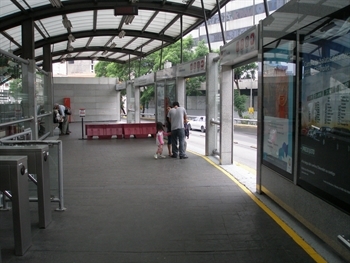
Photo by Pedro Cevallos-Candau
Riders wait to board at a Metrobus station in Mexico City.
 By Pedro Cevallos-Candau, Ph.D., PE
By Pedro Cevallos-Candau, Ph.D., PE - July 27, 2011
I arrived in Mexico City on a rainy Sunday afternoon, and one of my goals on this short trip was to get familiar with the Bus Rapid Transit system known as the Metrobus. Currently, the city has three active Metrobus routes, and a fourth is under construction. Since I was staying in a hotel near the Glorieta del Angel de la Independencia – the Angel of Independence monument, and a central gathering place in Mexico City – I planned to ride the Metrobus from Insurgentes, the longest avenue in Mexico City, to a large multi-modal transportation station called Buena Vista.
On my way from the airport to the hotel, I struck up a conversation with the taxi driver, a loquacious fellow who gave a lot of information about the system. He drove me by Avenida de los Insurgentes to show me the stations and buses. He also told me that the Metrobus has taken some business away from the taxis, but a lot of people considered it expensive (at a cost of about 50 cents U.S. per one-way ride). The driver also told me that the original pavement was damaged very quickly by the buses and had to be replaced with a stronger concrete pavement. He also was upset because the Metrobus has a dedicated lane, while the taxis have to compete for space with everybody else.
After checking in at the hotel, we took a stroll to Plaza de los Insurgentes, a round plaza with a lot of small shops and street vendors. Two Metrobus stations are located at the perimeter of the plaza, one in each direction. After we located a station, we found a vending machine, bought our tickets, and entered the station. Soon after, a red articulated bus pulled up to the station. I was impressed with the skills of the driver to be able to align the bus with the circular platforms.

A Metrobus station in Mexico City
Photo by Pedro Cevallos-Candau
Because of our lack of knowledge with the system, we boarded the Metrobus going the wrong direction; however this was not an issue because most stations load passengers in both directions. So we simply got off at the next station and quickly boarded a bus going in the right direction. The stations are very narrow but have multiple gates that open and close, allowing more than one bus to load and unload simultaneously during peak times. The buses are clean and comfortable, and soon we learned how to decipher the signaling system and had a nice ride to Buena Vista.
Chicago can learn two lessons from the Metrobus System:
- Dedicated bus lanes will require a heavy pavement design. Mexico had to rebuild the bus lanes after only a few years of usage.
- Avoid construction of stations that do not have a straight alignment, because it will be very difficult to meet all ADA requirements, especially the gap space between the bus and the platform.
Pedro Cevallos-Candau, Ph.D., PE is Executive Vice President at Primera Engineers, Ltd., and Co-Chair of Regional Planning and Investments Committee, Metropolitan Planning Council.